NEW YORK (Reuters Health) – Experienced endoscopists can significantly cut radiation exposure during endoscopic retrograde cholangiopancreatography (ERCP), a new study shows.
“We hope that awareness of this association might prompt endoscopists with less experience to minimize their fluoroscopy time, and to consider referral of more difficult cases to more experienced endoscopists,” the researchers say.
Fluoroscopy accounts for most of the radiation exposure during ERCP, according to lead author Dr. Jennifer E. Jorgensen and colleagues at the University of Michigan, Ann Arbor.
They say the median radiation dose during ERCP reportedly ranges from 1.8 to 12.5 mSv, compared with an average of 8 mSv from an abdominal CT and 3 mSv per year from natural background radiation.
To determine factors that influence fluoroscopy time during ERCP, the researchers used data from the ERCP Quality Network to analyze 8655 procedures, about half done by academic endoscopists and half by community-based practitioners.
In the April 26 online issue of Gastrointestinal Endoscopy, the investigators report that median fluoroscopy time was 3.0 minutes, ranging from 0.1 to 60.0 minutes. (They note that the radiation dose for 20 minutes of fluoroscopy time is about 30 mSv.)
A third of procedures – precut sphincterotomy, pancreatic stone extraction, biliary brushings, extraction of biliary stones > 10 mm, balloon dilation of a stricture, and placement of a hilar stent – required significantly longer fluoroscopy times (median 4.9 minutes vs 2.5 minutes).
Thirteen percent of procedures involved at least 10 minutes of fluoroscopy time, and 3% used at least 20 minutes.
“There was a significant interaction between annual volume of ERCPS and fluoroscopy-intense procedures for fluoroscopy time,” the researchers said.
For procedures requiring less fluoroscopy, endoscopists who performed 200 ERCPs. Endoscopists who performed 100 to 200 ERCPs in the previous year had a 27% increase.
For fluoroscopy-intense procedures, the least experienced endoscopists spent 59% more time with fluoroscopy, and intermediate-experience endoscopists spent 11% more time.
Every 10 years of experience was associated with a 21% decrease in fluoroscopy time for less intense procedures and a 20% decrease for more intense procedures.
The least experienced endoscopists were up to four times as likely to require at least 20 minutes of fluoroscopy time.
The authors advise that clinicians can partially control the amount of radiation exposure to patients by reducing the number of digital spot images taken and by using a lower pulse mode setting and lower image-intensifier magnification mode.
Endoscopists can also limit collimation, choose a lower dose setting, and position patients as close to the image intensifier and as far from the x-ray tube as possible. They can change the x-ray tube potential (kVP) by using an automatic algorithm that uses higher kVP.
Newer equipment, with modifications such as copper x-ray beam filtration and last image hold to reduce exposure, are also helpful.
“Increased awareness of radiation exposure has been shown to result in shorter fluoroscopy times,” the authors note.
“Increased awareness of the contributions of fluoroscopy time and other factors on radiation exposure and future risks of cancer to our patients may help endoscopists minimize these risks as much as possible to improve patient safety and outcomes,” Dr. Jorgensen and her team conclude.
Reference:
Gastrointest Endosc 2010.




